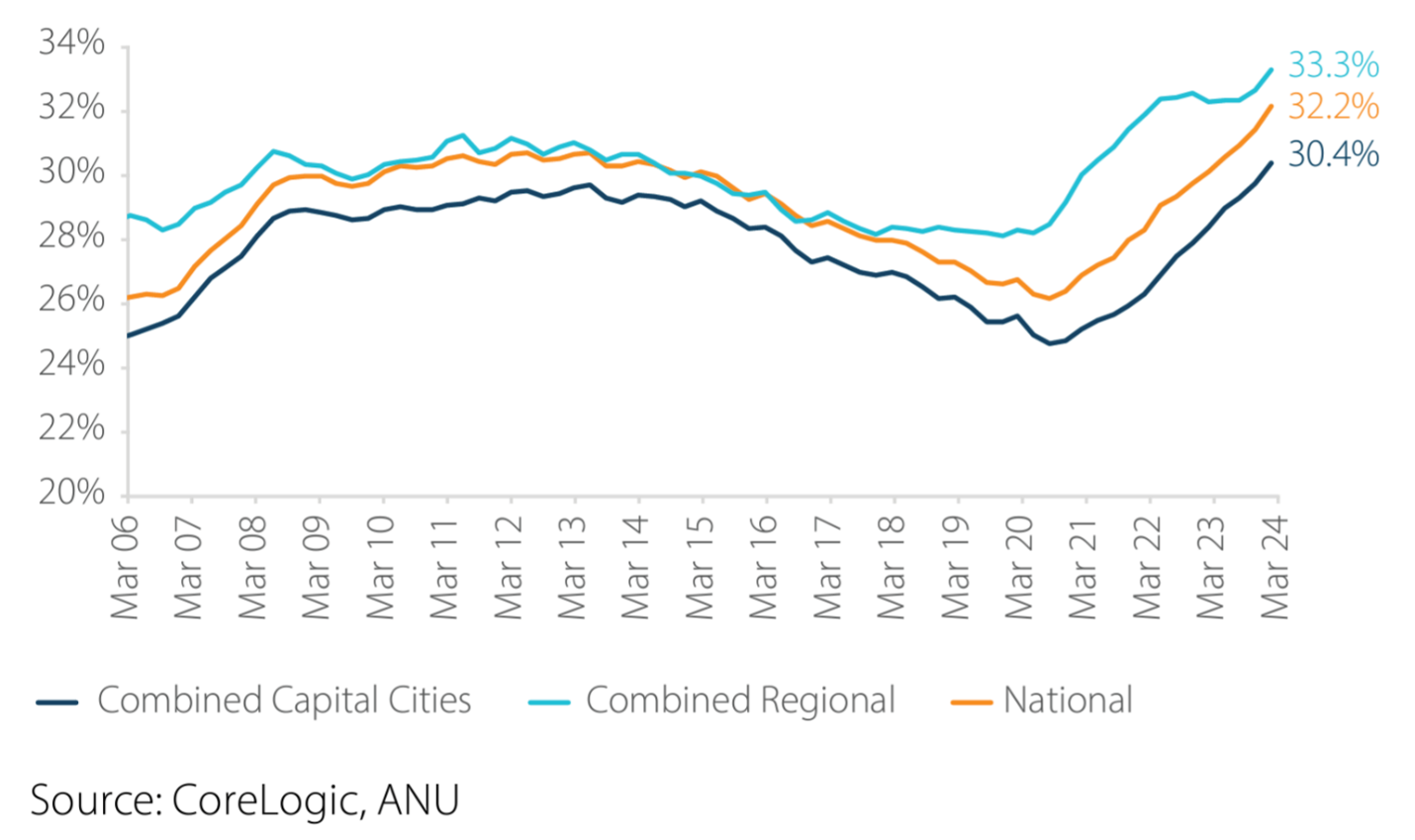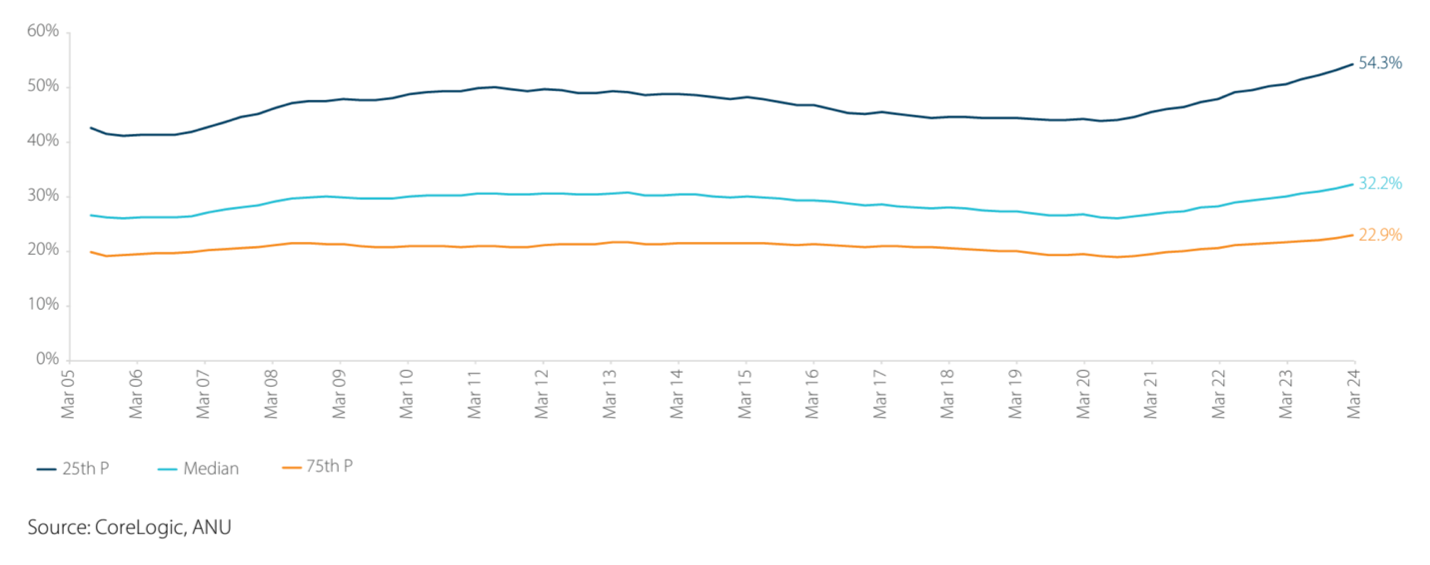-
Rapid increases in housing costs in recent years – impacting both mortgages and rents – has contributed to an ongoing deterioration in housing affordability, the latest edition of the ANZ CoreLogic Housing Affordability Report shows.
It finds the proportion of income required to service rents has shifted to the 30 per cent range rising from the mid-20 per cent range for median income earners in most parts of the country.
"We need to label this a crisis. And when you label something, a crisis, then you can start to say ‘rightio, let's not start by ruling things out. Let's just say everything's on the table and let's actually work out where we can start.” – Richard Yetsenga
The report also looks at the vulnerability of low-income earners.
Share of median income required to service median rent value
{CF_IMAGE}
The following is an edited extract of a conversation moderated by Caryn Kakas, Head of Housing Strategy at ANZ, on the release of the report.
Caryn Kakas: Access to rental accommodation has appeared as a significant policy debate in a way it never has before. Where do we see the potential in terms of offering more supply to ease demand?
Eliza Owen, Head of Research at CoreLogic Australia: A question that I often get asked is ‘when does this end?’. Like, what is the end to this rental crisis? And I think unfortunately, many of the solutions and things that need to resolve themselves - like a normalisation in the net overseas migration, for example - they take time.
The rental crisis is happening now and I think it's just leading to more insecure housing, homelessness. It's almost like triaging the resources to homelessness services and the people that need that support the most – as the sort of short-term resolution. Or trying to address some of it.
CK: Quite significant investment is required across the board, speaking of that, what do we think of construction starts falling behind what is needed?
Richard Yetsenga, ANZ Chief Economist: We need to work harder on new supply. We need to work harder on planning restrictions. We're not the only economy trying to build more dwellings.
But I don't think we will go anywhere close to genuinely being on the path to resolving this issue until we accept that town planning and new supply are insufficient.
We need to label this a crisis. And when you label something, a crisis, then you can start to say ‘rightio, let's not start by ruling things out. Let's just say everything's on the table and let's actually work out where we can start to have some movement and where we can actually deliver’.
CK: To unlock this investment in building we need skills and the capacity. What are some of the challenges that we're seeing in the marketplace to accessing those skills and the ability to get them onshore?
EO: I guess part of the challenge with immigration is that a relatively small portion of our construction sector is made up of new migrant arrivals, and there are some barriers there when it comes to levies or reskilling that act as a barrier from getting people quickly, from qualified trades overseas, to working in Australia.
RY: I think, this is a taste of what an ageing demographic looks like. You know, people think about demographics as something that typically move slowly. But we're right in a demographic phase shift in Australia, whereby, to just use one statistic - the over 80s population in the last two decades has risen at about 25,000 people a year and starting from 2028, that demographic will be rising at about 65,000 people a year.
This ability to tap into kind of middle aged, mature workers with lots of experience in sectors that take significant skill, I think this talent shortage is quite structural.
And really, what resolves this challenge is the harder we can push on productivity, the less we have to prioritise what we do.
And certainly, I think in the public policy debate, there's still so much debate on what a government is doing, , and not nearly enough discussion about how are we going to make it easier to get all the stuff done. And if we spent more time on that, I think ultimately, we'd be wealthier, better off, and also more equal.
Jess Caire, Property Council of Australia Executive Director: Richard raised a good point about the ageing demographic. And to go back to the housing challenge, it’s about making sure that we can make it as easy as possible for people to move through the housing typology. You've got people who are in a four-bedroom homes eager to downsize. We've got to remove all those barriers.
I think the challenge that we have is, is we're looking at things in individual silos rather than this holistic ecosystem and in a more coordinated effort.
CK: Are we seeing some opportunities in terms of groups that haven't actively participated in the housing debate? For instance, people who are renting for longer and how that plays out in the marketplace.
EO: They're becoming a bigger part of the political conversation. Just because rates of ownership are declining and the number of renters are rising. So we saw that with the National Cabinet’s better deal for renters, and it's good that it's highlighting some of the issues, that even when the rental market was cheap, we still have an issue with, relatively short leases, the quality of the rental housing provided. And these are things that build-to-rent can help to fill the gap on as well in terms of that quality and longevity for people who do not end up not owning a home.
Portion of income to service rent
National, dwellings
{CF_IMAGE}
CK: What is one silver lining opportunity that we see that helps us navigate through this?
JC: I don't think there's one thing, but I do think there has to be a commitment to boosting supply and removing the roadblocks and giving ourselves permission. When I say “ourselves” I mean the collective, giving ourselves permission to remove break down the barriers and to try things that we haven't tried before in order to get supply to market faster.
Jeff Whalley is a Journalist with bluenotes
The views and opinions expressed in this communication are those of the author and may not necessarily state or reflect those of ANZ.
-
-
anzcomau:Bluenotes/Housing,anzcomau:Bluenotes/global-economy,anzcomau:Bluenotes/Economics
Tackling the rental crisis
2024-04-24
/content/dam/anzcomau/bluenotes/images/articles/2024/April/gryffyn-m-Z4RvGiREzKA-unsplash (1) Large.jpeg
EDITOR'S PICKS
-
Most focus falls on supply issues in the housing affordability debate – but a broader view on the use of existing stock has the potential to be more effective.
22 April 2024 -
April’s edition of the ANZ CoreLogic Housing Affordability Report is a guide to the main trends and drivers of housing affordability across Australia.
16 April 2024


